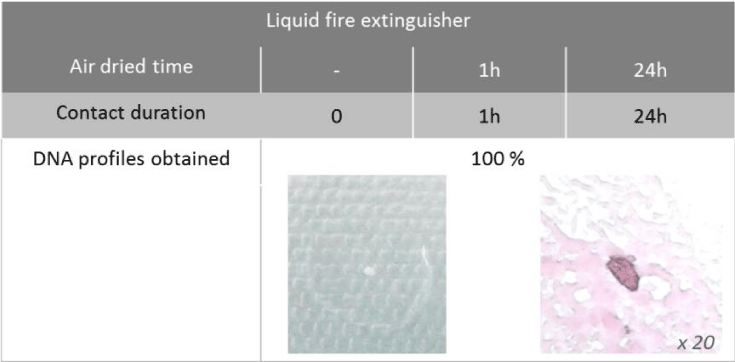Forensic Sci Today
Persistence of Stains and DNA on Evidence in Hostile Situations
Piters Alice, Esponda Audrey, Beaufils Martine, Monique Guillaume, Doutremepuich Antoine, Doutremepuich Christian*
Cite this as
Alice P, Audrey E, Martine B, Guillaume M, Antoine D, et al. (2016) Persistence of Stains and DNA on Evidence in Hostile Situations. Forensic Sci Today 2(1): 010-012. DOI: 10.17352/fst.000006In order to exploit DNA evidence, biological liquid must be detected and recovered. It has been suggested that some hostile conditions like a long water soaking period may have an influence on evidence recovery and thus results and interpretation. These researches demonstrate that adapting a protocol for each situation allows to recover any evidence. It still possible to detect and identify blood stain after a washing machine even at 90°C. For semen stain, detection is not possible due to the elimination of the acid phosphatase, but spermatozoa can persist on clothes and a DNA profile can be obtained. Contact cells can be recovered on support which has been immerged in water even several weeks or in contact with fire extinguisher powder or liquid. This study shown that if cells dry enough time to adhere to the support (>1 hour) before water immersion, it is possible to obtain a DNA profile.
Background
During evidence treatment of a crime scene, several factors can affect DNA analysis. First of all, presumptive tests are used to detect semen or blood stains and allow to localize samples. Blood detection is performed by detecting the presence of hemoglobin. For this, two methods are used: Luminol is sprayed directly on the support and can detect blood traces (up to 10 million times diluted, [1-3]). Phenolphthalein or Kastle Meyer solutions are applied on a filter paper which is press on the location of blood stain [3-5]. These methods are sensitive sufficient to be used routinely on evidence and then recover enough DNA to obtain profiles.
Semen stains detection is realized by detecting the presence of seminal liquid and acid phosphatase. A microscopic examination is used to confirm the presence of spermatozoa in the samples. Cells are directly collected on support and no presumptive test use.
DNA extraction are performed on collected samples (cell, blood, spermatozoa) and permit to remove PCR inhibitors present in the samples.
Today new technology allows to detect low quantity of biological stain and obtain DNA identification. Some molecules or conditions on the crime scene can interfere in the detection, the recovery or the revelation of biological liquids.
This study explore some impact of hostile environment on DNA evidence investigation and how technicians can adapt laboratory protocol to crime scene reality.
Materials and Methods
Sample and support
Blood, semen and cell samples are obtained from one donor and deposited on a clean support (glass slide or cotton). A standard volume is applied on a piece of fabric and air dry at room temperature.
Stain cleaning
Piece of fabric are cleaned independently with a washing machine at 30, 60 or 90 °C programs (Table 1) with detergent. Pieces of fabric are air dried and stored at room temperature until examination.
Glass slide, water immersion and cell visualization
Slides are immersed in water at room temperature and air dried according to the protocol. Glass slide are colored with Nuclear Fast Red and examined under X20 magnification.
Stain detection and samples collection
Semen stains are tested for presence of seminal liquid by acid phosphatase using brentamine fast blue technique. Cotton fabric are cutted out and spermatozoa are observed after glass preparation and coloration with hematoxylin-eosin.
Blood stains are tested for the presence of blood by peroxidase using luminol method (Bluestar, according to the manufacter recommendations) and Phenolphtalein method (Kastle Meyer KM) and collected by cut (cotton fabric). Cells are collected by using moistened swab.
DNA extraction, amplification and detection
Blood and cell samples are extracted with EZ1 extraction method (EZ1 Investigator Kit, Qiagen, US) and performed with EZ1 Advanced XL automate according to manufacturer recommendations. Semen stains are subjected to differential extraction method, cells and spermatozoa fractions are separated. PCR is performed on each sample extract using the Investigator® 24plex kit (QIagen). Products are detected using the 3500 genetic analyzer (Applied bio systems).
Results and Discussion
Persistence of blood stain and DNA from laundered clothes
The objective of this study is to determine if after a washing it is still possible to detect chemically and to obtain DNA profiles on blood stains.
Blood stains are detected by KM method on 30 °C laundered samples regardless of the volume used. At 60 °C, detection is positive for volume upper 3 µL. At 90 °C detection is not possible. With luminol method [2], a positive detection is observed for any temperatures or volumes used (Table 2). DNA is recovered on all samples and high quality DNA profiles are obtained (Table 3) excepted for 1 µL blood volume at 90°C.
Luminal and KM detection [4], are presumptive blood tests with a sufficient sensitivity to detect blood stain on laundered clothes. Washing induce a dilution of the stain but not its elimination and even after a 90 °C wash, it is possible to detect and identify blood stains. Detergent use has no impact on cells or DNA integrity. In the conditions of analysis, transfer from contaminated piece fabrics on control in washing machine are not observed.
Persistence of semen stains and DNA from laundered clothes
The objective of this study is to determine if after a washing machine it is still possible to detect chemically, to recover spermatozoa and to obtain DNA profiles on semen stains.
Detection is not possible on laundered clothes because of elimination of semen liquid and acid phosphatase as it is already describe in literature [6-8]. But by targeting sample, it is possible to recover spermatozoa and obtain a DNA profile. Detergent use has no impact on cell or DNA integrity. These results indicated that spermatozoa are retained during washing and can be recovered for DNA analysis and thus confirmed the findings of previous research.
Persistence of cells on support immerse in water
The objective of this study is to observe the persistence of cells on support surface after water immersion. Buccal cell are deposited on a glass slide and air dried during 10 minutes, 1 hour or 24 hour or 1week. Slides are immersed in water (21 °C) during 10 minutes, 1 or 24 hours and 1 week. Slides are observed under microscope after Nuclear Fast Red coloration and count (Figure 1). Without drying, cells are eliminated in the water and can’t be observed. After 10 min or 1 h drying regardless of the time in water, between 10 and 100 cells are observed. After 24 h and 1 week of drying, more than 100 cells are obtained, equivalent to control slide (without water immersion). After 1 hour of drying, cells adhere to the support and regardless of the time in the water it is possible to recover cells and DNA.
Cell DNA identification on evidence after a contact with fire extinguisher powder or liquid
The aim of this study is to determine if after acontact with powder (containing potassium bicarbonate) or liquid containing in a fire extinguisher is it possible to recover cell and DNA.
Buccal cells are deposited on glass slide and air dried during 1 or 24 hour. Powder or liquid from fire extinguisher are deposited on cells and incubate at room temperature during 1 or 24 hours. Cells are recovered with moistened swab, observed through a microscope and DNA extractions are performed on samples (Figures 2,3). These results allows to conclude that cells recovery on support with powder or liquid containing in fire extinguisher is possible. Contains of fire extinguisher has no impact on cells or DNA purity and doesn’t inhibit DNA amplification.
Conclusion
Evidence exploitation of a crime scene depends on the evidence recovery conditions and interpretation of presumptive tests detection. All these studies allowed adaptation on evidence treatment depending of the scene crime condition.
These findings demonstrate that after a washing or water soaking: blood detection and DNA identification are possible even for low blood volume (1 µL) and high wash temperature [7].
Semen detection is not possible after water immersion but spermatozoa are retain on clothes and can be identifies. And cells which dried at least one hour on a support before immersion in water can be recovered and analyzed in molecular biology.
The methods of detection used are sensitive enough to detect blood stain after a washing with high temperature or on burned clothes. Presumptive tests for semen stains permit to localize on support semen liquid. In case of laundered clothes, semen liquid is washed away but spermatozoa persist on fabric and DNA profiles can be obtained.
It has also been shown that some components, like powder or liquid, contain in fire extinguisher don’t have impact on cell or DNA recovery.
In conclusion, for blood or semen stains, evidence exploitation is possible in hostile situation but technicians have to adapt protocol to the crime scene. Contact cells can be recovered and analyzed even after standing in water several days.
- Butler JM (2011) Advanced topics in forensic DNA typing: Methodology. Edited by Elsevier Academic Press .
- Nilsson A (2006) The forensic luminol test for blood: unwanted interference and the effect on subsequent analysis. Project Microbial Biotechnology: 1- 10 .
- Spalding R (2006) Identification and characterization of blood and bloodstains. In Forensic Science: an introduction to scientific and investigative techniques Stuart HJ, Jon J NORBY (eds), CRC Press, Boca Raton FL, 181-201 .
- Glaister J (1926) The kastle meyer test for the detection of blood. Br Med J 10: 650-652 .
- Higaki R, Philip W (1976) A study of the sensitivity, stability and specificity of phenolphthalein as an indicator test for blood. Can Soc Forens Sci J 9: 97-102 .
- Kafarowski E, Lyon AM, Sloan MM (1996) The retention and transfer of serpmatozoa in clothing by machine washing. Can Soc Forens Sci J 29: 7-11 .
- Spector J, Von Gemmingen DV (1971) The effect of washing on the detection of blood and seminal stains. Can Soc Forens Sci J 4: 3-9 .
- Brayley-Morris H, Sorrell A, Revoir AP, Meakin GE, Court DS, et al. (2015) Persistence of DNA from laundered seme stains: implications for child sex trafficking cases. Forensic science international 19: 165-171.
Article Alerts
Subscribe to our articles alerts and stay tuned.
 This work is licensed under a Creative Commons Attribution 4.0 International License.
This work is licensed under a Creative Commons Attribution 4.0 International License.




 Save to Mendeley
Save to Mendeley
